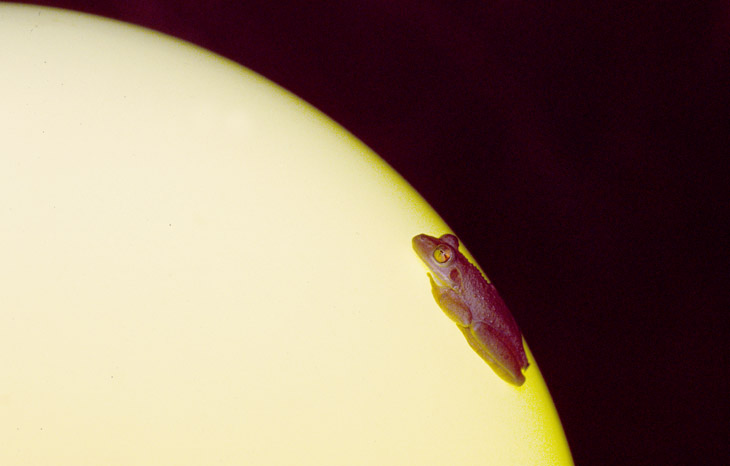
I’ve been saving these images specifically for this post, because I figured I’d slap them all up together. On this past beach trip, I ended up seeing more crab species than anything else, and producing some of the best images of the trip with them – of course, that’s a matter of opinion. And as I said, I did almost no insect photos, a rarity for me, but plenty of arthropod images: crustaceans are a subphylum of the Arthropoda, so more closely related to bugs and spiders than to the molluscs and fish that they hang around with.
So I open with the image above, which I like for the bizarre effect. This was an Atlantic blue crab (Callinectes sapidus) hanging out in the shallows of the sound, shot through the water from the deck, and the reflection not only produced a surreal overlay, it’s actually a selfie – I can be seen leaning over the rail with the camera raised.
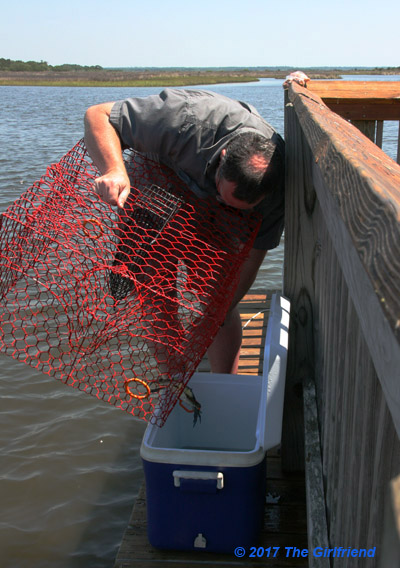 The place we rented actually provided a crab pot for our use, so we had blue crabs for a couple of the meals that week – the first, just as an appetizer since we didn’t catch enough that day, but later in the week the haul was better and the people to be fed fewer, so The Girlfriend and I got a decent meal of them. Blue crabs are notoriously aggressive, as I already knew from Florida, and challenging to handle – I managed to get pinched a couple of times, even drawing blood once. But they’re tasty, and easy to prepare if not exactly easy to get the meat from.
The place we rented actually provided a crab pot for our use, so we had blue crabs for a couple of the meals that week – the first, just as an appetizer since we didn’t catch enough that day, but later in the week the haul was better and the people to be fed fewer, so The Girlfriend and I got a decent meal of them. Blue crabs are notoriously aggressive, as I already knew from Florida, and challenging to handle – I managed to get pinched a couple of times, even drawing blood once. But they’re tasty, and easy to prepare if not exactly easy to get the meat from.
[Yes, that’s me, sporting my fashionable pink yarmulke. I promise not to appear again in this post.]
Of course we had a lot of seafood while out there: huge shrimp, tender mussels, red snapper, a few various whitefish, some scallops and oysters, and the blue crabs. All of it was caught the day we had it, and while this isn’t a huge difference from fresh-frozen stuff available at the local supermarket here, it’s still noticeable, especially the mussels. But yeah, I’d rather have the shrimp prepared at least…
As noted from last year’s Outer Banks trip, the area is home to the Atlantic ghost crab (Ocypode quadrata,) which I saw fewer of than expected, but I wasn’t really out on a serious hunt for them this time. Navigating by flashlight on the beaches at night, they can easily be found near the surf line, and they’re not as readily confused as frogs; even when you keep the light on them, they’re usually aware of your approach, and will skitter off into the waves when they feel it’s getting too dangerous. By day they’re usually burrowed down into the sand, though at early morning you might still find them foraging, or excavating their dens. One day we went up to the end of the island by the New River Inlet, and The Girlfriend spotted a large specimen far from its protective burrow. This began a short modeling session, with great reluctance on the crab’s part.

After a brief chase across the sand, I positioned myself for best use of the light while The Girlfriend shifted to block the crab’s retreat, and I managed to crawl in close for a portrait. With average leg spread as seen here, this one measured roughly 12cm, and those compound eyestalks provided a 360° field of view horizontally and perhaps a full 180° vertically. And, as noted, a useful amount of distance vision – it occurs to me now that I should have experimented when approaching them at night with the flashlight, attempting to keep it in the same vertical and horizontal position so it didn’t apparently shift with my approach, to see if that kept them from being spooked. Next time, I guess.
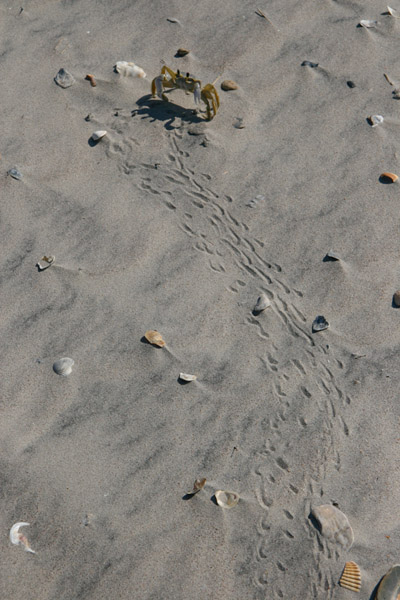 Their trails across the beach are distinctive, but subtle: lots of little hash marks with no visible toes or clear two-legged patterns, and typically a bit of wandering. Of course, if this leads up to a hole with a fresh mound of sand at the edges, identification is not really an issue. Or if, you know, you find the culprit still standing at the end of the trail. You can always feel pretty confident about what made the tracks when you find a tableau like seen here – that’s a little nature photographers’ secret (that I stole from a little nature photographer. Though I suppose if you parse it a certain way you could call me a little nature photographer, at least until I go to Africa and start shooting elephants and such.)
Their trails across the beach are distinctive, but subtle: lots of little hash marks with no visible toes or clear two-legged patterns, and typically a bit of wandering. Of course, if this leads up to a hole with a fresh mound of sand at the edges, identification is not really an issue. Or if, you know, you find the culprit still standing at the end of the trail. You can always feel pretty confident about what made the tracks when you find a tableau like seen here – that’s a little nature photographers’ secret (that I stole from a little nature photographer. Though I suppose if you parse it a certain way you could call me a little nature photographer, at least until I go to Africa and start shooting elephants and such.)
This crab had a definite idea of where safety lay, even if it had lost track of exactly where its burrow was located, because once we shifted position past a certain point, the anxious crustacean made a break for it and scampered off across the sand at an appreciable turn of speed, faster than a human walking pace certainly, and was several meters away when it just vanished. Curious, since it didn’t look like the mouth of a burrow, I followed it again to find that it had simply reached sand that was much looser and less-packed than the tidally-flattened stuff where we had first encountered it. The process of burying itself was near-instantaneous, and while the grey patch atop the carapace didn’t exactly blend in with the sand, it became subtle enough to be mistaken for a seashell by the seashore – at least, if you were paying no attention to the trail leading up to it or the curious mounding pattern of the sand. But of course no one reading this blog would miss those.
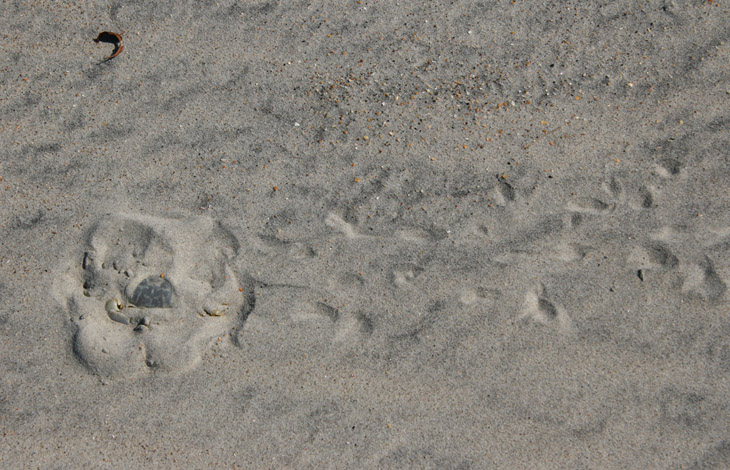
On the same day, and in the same location, that we encountered the sea hare/sea slug/angel loogie, The Girlfriend spotted a couple of little fiddler crabs on the beach. Fiddlers can be notoriously hard to identify, since there are only a hundred species in North America with subtle differences between many, but I’m going to tentatively identify these as the Atlantic sand fiddler (Uca pugilator, so named for their boxing-style behavior, as opposed to Uca thurman, which does more of a sword-fighting style. That’s a, I say, that’s a joke, son! I made a funny.) I managed to slip in pretty close to one for a portrait session, then scooped up another so The Girlfriend could do a scale shot.
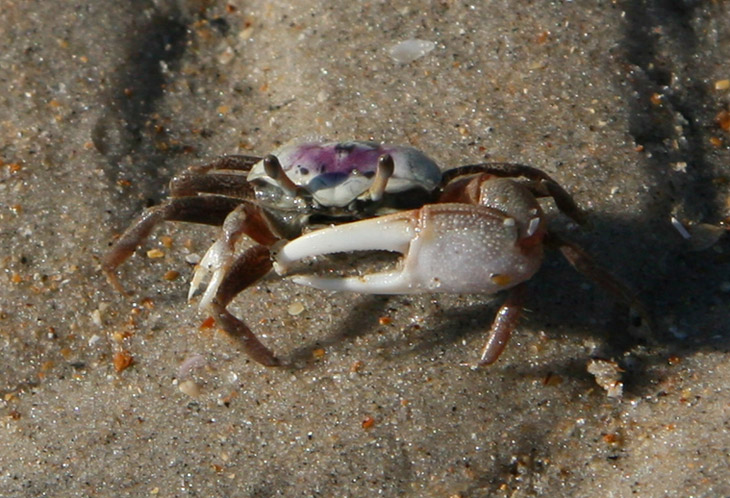
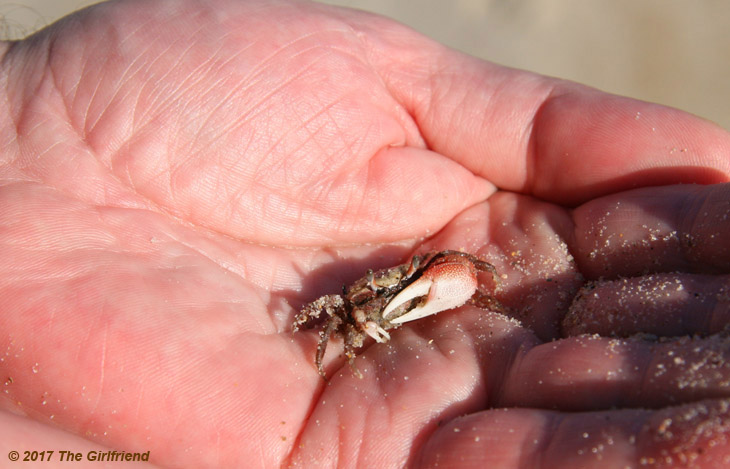 Fiddlers tend to congregate, mostly on mud flats or among marsh grasses, but may be found wandering just about anywhere near the beach – they just require occasional moisture. The last few times I’ve seen them, they were doing territorial displays, waving the big pincer in the air like a flag, even though there wasn’t a taxi to be found.
Fiddlers tend to congregate, mostly on mud flats or among marsh grasses, but may be found wandering just about anywhere near the beach – they just require occasional moisture. The last few times I’ve seen them, they were doing territorial displays, waving the big pincer in the air like a flag, even though there wasn’t a taxi to be found.
That portion of the beach had a swale, a low-lying area that would obviously flood inland in a small channel during high tide, and the channel was still damp when we were there. And suddenly, I focused better on the ground, and realized I wasn’t seeing gravel or shells.
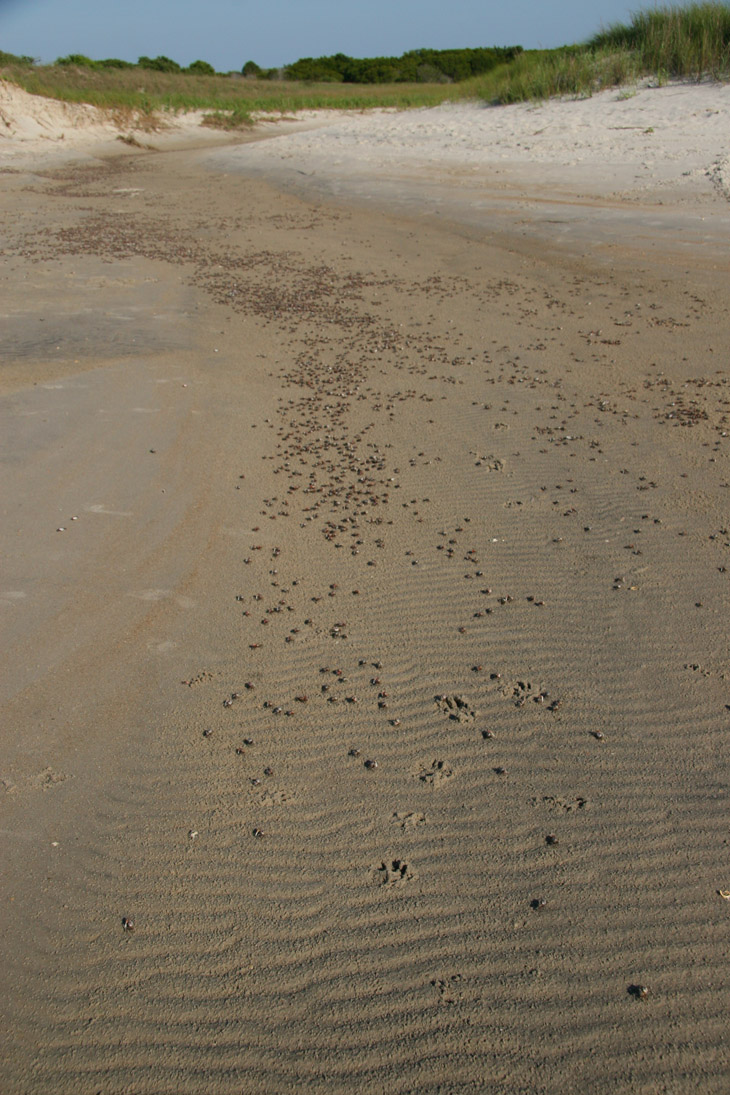
It would be nice to say the ground was crawling with them, but they actually weren’t moving much. When I waded into their midst (the masses parting for me daintily,) the ground was covered with the little sand balls that’s evidence of their eating habits, so I figure it’s safe to say that the tide brought in lots of the microorganisms that they like. What puzzles me is why there weren’t hordes of seagulls gorging themselves on such easy targets, but maybe an army of fiddlers is just something you don’t mess with. I was safe because they recognized my benign intentions. Yeah that must be it.
The pilgrimage went at least fifty meters inland to its terminus at a micro-pond, little more than a puddle but giving indications that it was semi-permanent. There, the crabs clustered so tightly at the water’s edge that the ground was invisible beneath them.

Only the males have an oversized claw, and while it looks like a lot of males in the pic, there were definitely females among them. It would be easy to believe that this was a cluster of dead and washed-up crab bodies, but they were all very much alive in this pic.

They’d largely halted at the edge, though a couple had waded in like the die-hards at the beach when the water’s too cold. Which wasn’t the best of moves on their part.
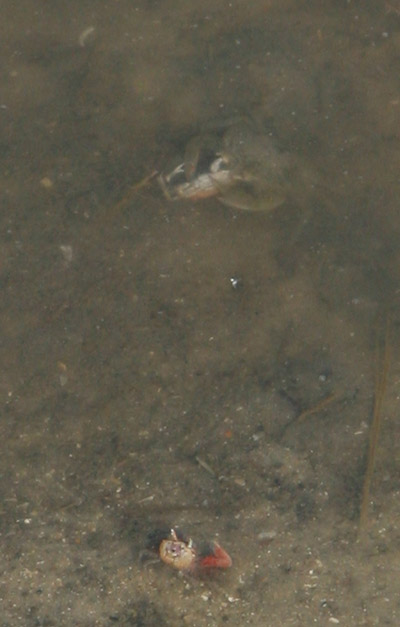 I saw a flash of movement from within the pond/puddle, and realized that a medium-small unidentified aquatic crab lived within the water, and had dashed forward to snatch a fiddler to snack upon. It can be seen here, with its meal, towards the top of the image, while another daring/stupid fiddler sits not far off towards the bottom – all of this is through the water’s surface so it’s a tad murky. Spending a little time in observation, I could see that there were several of the larger crab species within the pond, but they seemed reluctant to leave the water even with abundant meals right at the edge.
I saw a flash of movement from within the pond/puddle, and realized that a medium-small unidentified aquatic crab lived within the water, and had dashed forward to snatch a fiddler to snack upon. It can be seen here, with its meal, towards the top of the image, while another daring/stupid fiddler sits not far off towards the bottom – all of this is through the water’s surface so it’s a tad murky. Spending a little time in observation, I could see that there were several of the larger crab species within the pond, but they seemed reluctant to leave the water even with abundant meals right at the edge.
By the way, I did return the next day with the video SLR, arriving while the tide was high enough to provide a complete channel to the pond, and could see the aquatic crabs, but never snagged one capturing any prey. They were also aware of my presence and would tend to hide as I approached, and between the sun and The Girlfriend waiting nearby, I could only devote so much time to the pursuit, especially since I’d been snorkeling a little earlier and had reached my limit for exposure.
By the way, while I was stepping carefully through the band of fiddler crabs that filled the swale, on the first day, I spied a tiny crab on the sand, and carefully captured it for another pic. I’m fairly certain that this isn’t a fiddler, but I’m not sure what it is; in carapace shape, it vaguely looks like the next species I’m going to talk about.
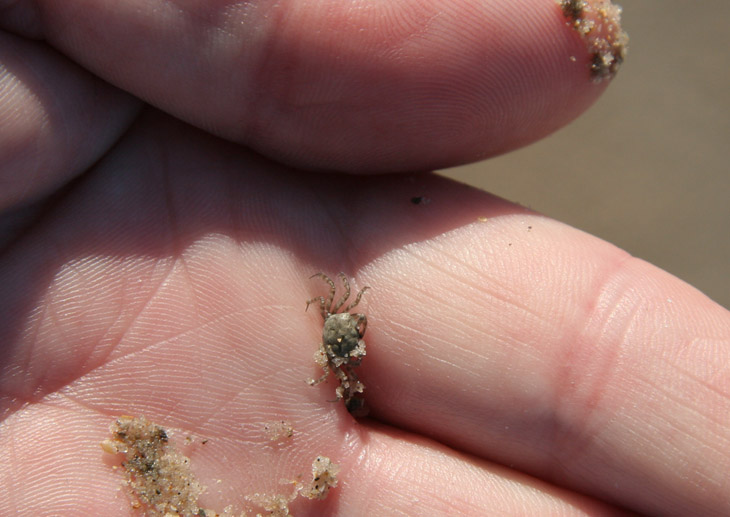
While I wasn’t sure about finding the fiddlers or this tiny one, I was pretty certain I’d see examples of everything else that I’ve covered, including one that I haven’t mentioned yet. The marshy and reedy area bordering the sound was ideal habitat for marsh crabs, primarily nocturnal crustaceans that can often be found plying the peat between reeds, if not climbing the reeds and docks themselves. Which is exactly where I found them.
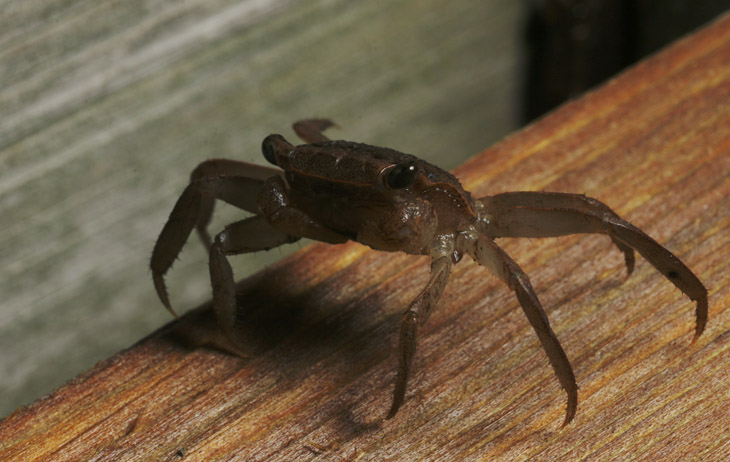
I feel pretty confident that this is a Sesarma cinereum, because the other closest species has a distinctive difference, another point to the carapace right at the eye orbit. They seemed even less dazzled by the bright flashlight than the ghost crabs, and endeavored to slip from sight when I found them; this one in particular had gone over the edge of the wood, easily able to cling to it, but was flushed back up on top by my fingers coming in from the underside.
 Generally, they’re placid little beasts, ambling slowly along the pilings and reeds that climb from the wetlands of their home, and they feed mostly on the new vegetation, and occasionally on fiddlers (which I did not see anywhere near this area, right outside the back of the condo.) I was lucky enough to find a few on the deck, and a few on the reeds alongside, all within relatively easy reach while photographing. They can get themselves into some pretty tight cracks, for instance between boards, but I wanted to do some detail pics and so I had a small container to scoop up a few if I got the chance. It turned out to be relatively easy, but then again I got it going on, so I make it look easy. You’d probably have a much harder time of it, if not finding it completely impossible…
Generally, they’re placid little beasts, ambling slowly along the pilings and reeds that climb from the wetlands of their home, and they feed mostly on the new vegetation, and occasionally on fiddlers (which I did not see anywhere near this area, right outside the back of the condo.) I was lucky enough to find a few on the deck, and a few on the reeds alongside, all within relatively easy reach while photographing. They can get themselves into some pretty tight cracks, for instance between boards, but I wanted to do some detail pics and so I had a small container to scoop up a few if I got the chance. It turned out to be relatively easy, but then again I got it going on, so I make it look easy. You’d probably have a much harder time of it, if not finding it completely impossible…
One of the two specimens that I collected had a little surprise for me, one that I didn’t make out until I got the light just right, and then I had to make sure the flash angle was adequate so it came out in the photos. This actually is an issue that I run into more than occasionally: while the light that I’m using to spot the critters at night may be shining directly on them, the flash is off to the side of the camera at a different angle, and the results from the photos can be different. So I made sure that I got what I needed, and produced one of my favorite animal photos from the trip, and perhaps even so far this year:

Yes, those are her eggs, which according to one source may number from 5,000 to 13,000, held in her pleopods. So okay, you’re familiar with shrimp, which have a lot of little fins under their abdomens/tails with which they swim? Crabs have them in a way too, belly ‘scales’ that usually remain tightly folded against their undersides, but they carry their eggs in them (as do shrimp) and can even use them to swim – we watched a very small blue crab doing this near the deck one day while we were out there. I naturally hadn’t realized she was packing when I caught her, but I’m not sure how much difference it makes – she was out foraging with the others on the deck, and nothing that I did would have affected the eggs in any way. She was returned to where I found her as soon as I was done that night, less than an hour after capture, and now she has a story to tell the kids.
And that’s going to wrap it up with the post-trip posts, though the occasional image will undoubtedly creep in here and there. It was a great vacation and we got to indulge a lot, with little marring it at all; too often, the drive or the prep or the conditions or something else make such trips less than ideal – we all have memories of those, don’t we? This one was largely all positive. And so I close with one last marsh crab, the morning after my modeling session above, peeking up from between the boards of the deck immediately after sunrise – the same sunrise, in fact, as the first pic from the first post about the trip, just ten minutes later. I loved the subtle aspect of it, made less subtle by the elongated shadow. We now return to our regularly scheduled bugs…


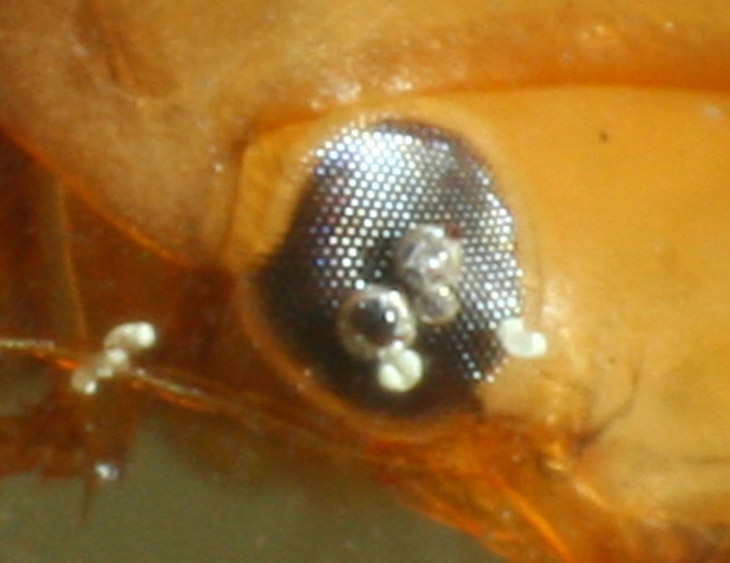




















































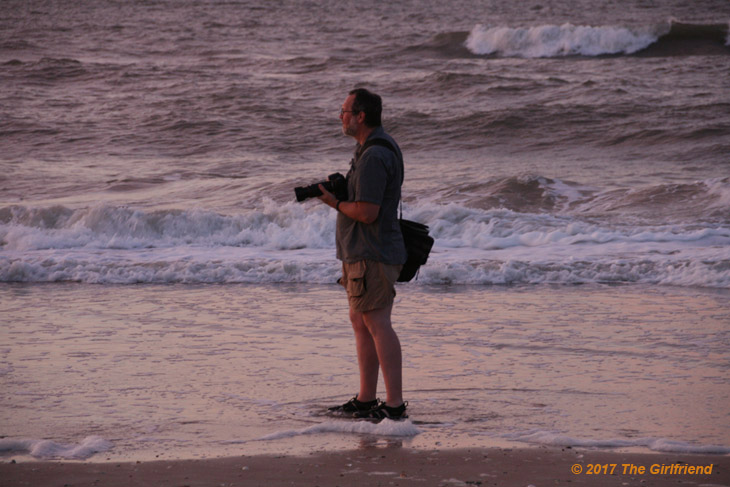

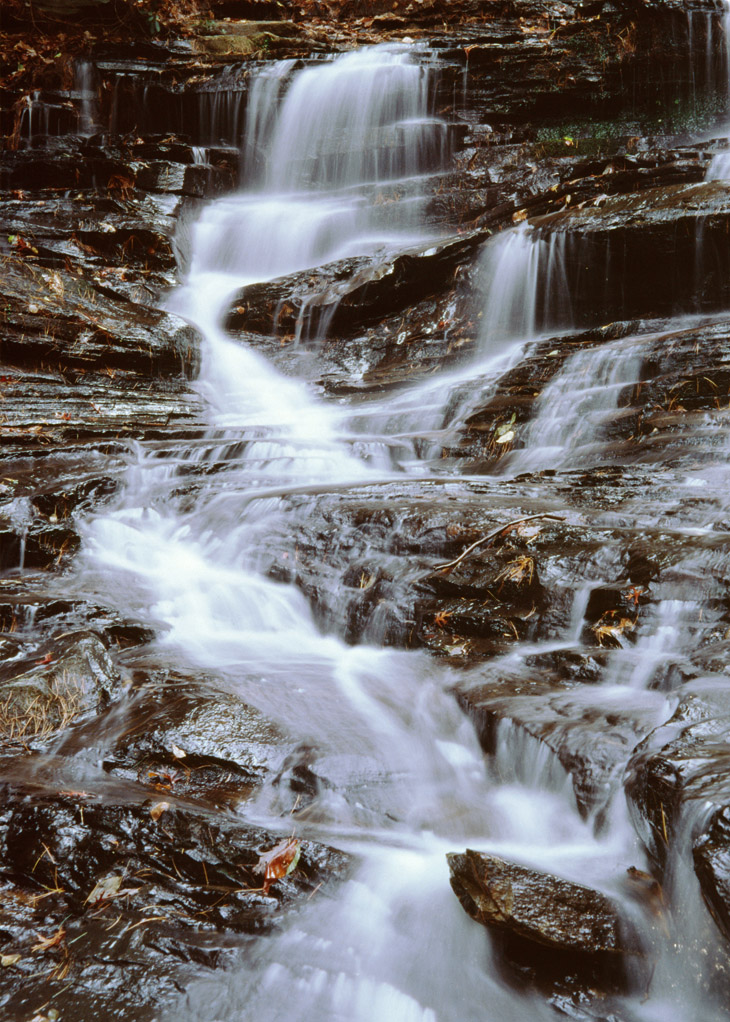

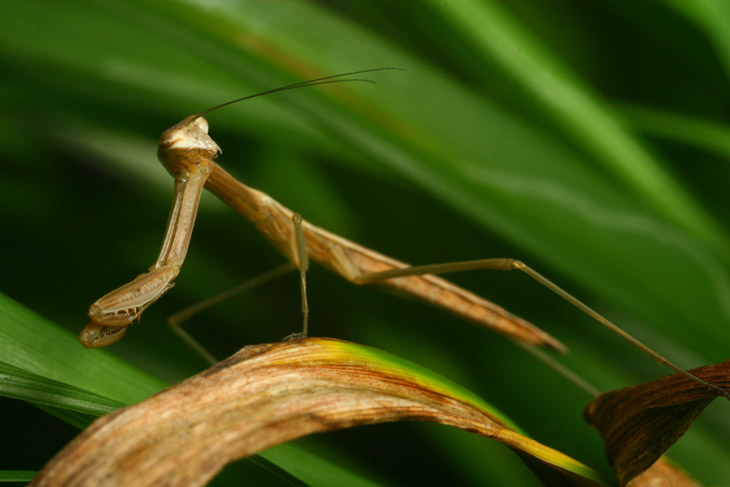
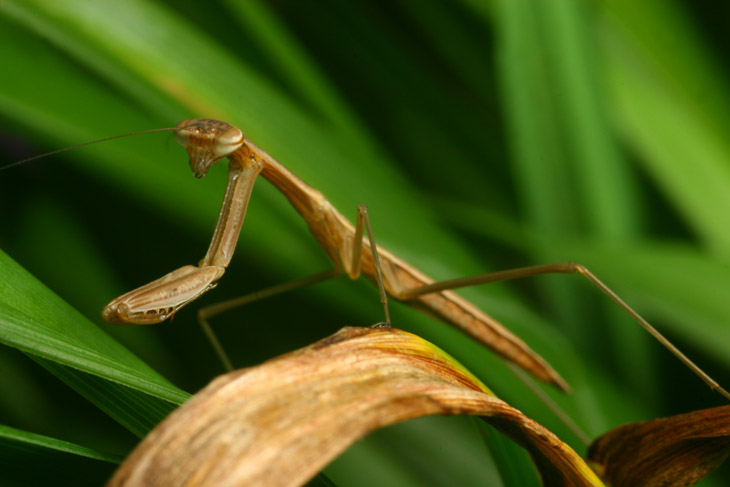


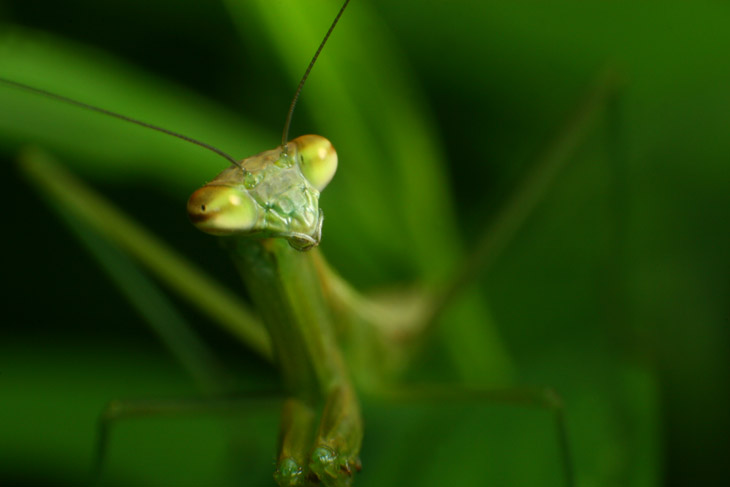
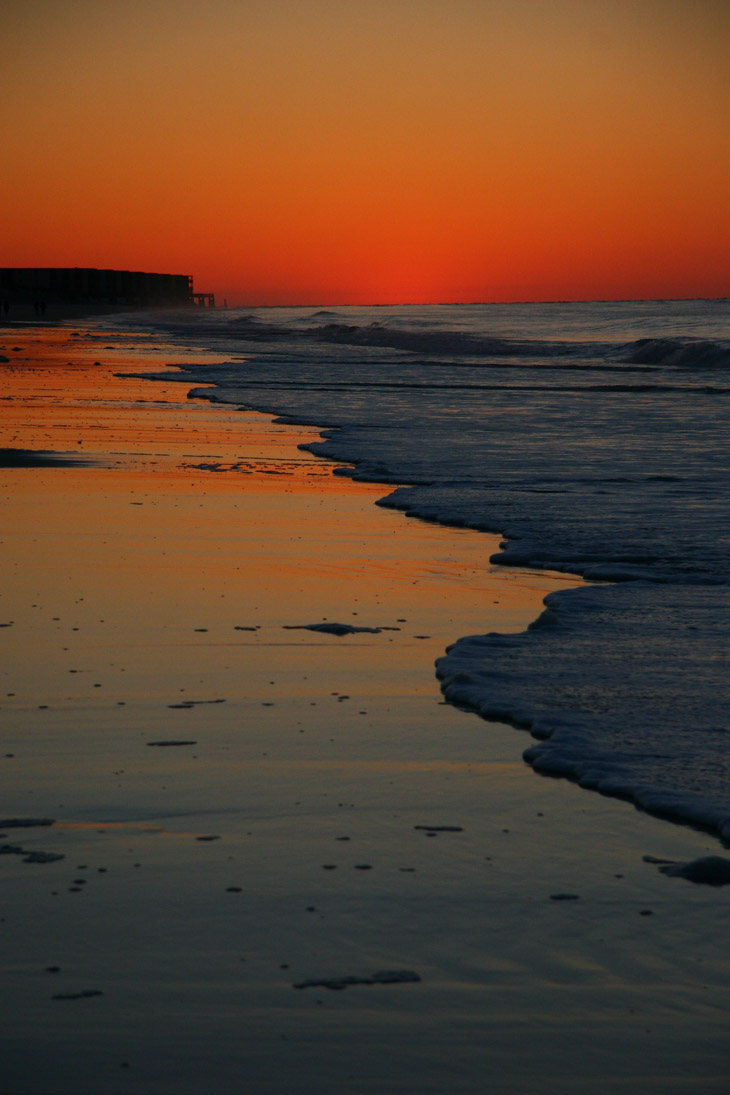

 The place we rented actually provided a crab pot for our use, so we had blue crabs for a couple of the meals that week – the first, just as an appetizer since we didn’t catch enough that day, but later in the week the haul was better and the people to be fed fewer, so The Girlfriend and I got a decent meal of them. Blue crabs are notoriously aggressive, as I already knew from Florida, and challenging to handle – I managed to get pinched a couple of times, even drawing blood once. But they’re tasty, and easy to prepare if not exactly easy to get the meat from.
The place we rented actually provided a crab pot for our use, so we had blue crabs for a couple of the meals that week – the first, just as an appetizer since we didn’t catch enough that day, but later in the week the haul was better and the people to be fed fewer, so The Girlfriend and I got a decent meal of them. Blue crabs are notoriously aggressive, as I already knew from Florida, and challenging to handle – I managed to get pinched a couple of times, even drawing blood once. But they’re tasty, and easy to prepare if not exactly easy to get the meat from.
 Their trails across the beach are distinctive, but subtle: lots of little hash marks with no visible toes or clear two-legged patterns, and typically a bit of wandering. Of course, if this leads up to a hole with a fresh mound of sand at the edges, identification is not really an issue. Or if, you know, you find the culprit still standing at the end of the trail. You can always feel pretty confident about what made the tracks when you find a tableau like seen here – that’s a little nature photographers’ secret (that I stole from a little nature photographer. Though I suppose if you parse it a certain way you could call me a little nature photographer, at least until I go to Africa and start shooting elephants and such.)
Their trails across the beach are distinctive, but subtle: lots of little hash marks with no visible toes or clear two-legged patterns, and typically a bit of wandering. Of course, if this leads up to a hole with a fresh mound of sand at the edges, identification is not really an issue. Or if, you know, you find the culprit still standing at the end of the trail. You can always feel pretty confident about what made the tracks when you find a tableau like seen here – that’s a little nature photographers’ secret (that I stole from a little nature photographer. Though I suppose if you parse it a certain way you could call me a little nature photographer, at least until I go to Africa and start shooting elephants and such.)

 Fiddlers tend to congregate, mostly on mud flats or among marsh grasses, but may be found wandering just about anywhere near the beach – they just require occasional moisture. The last few times I’ve seen them, they were doing territorial displays, waving the big pincer in the air like a flag, even though there wasn’t a taxi to be found.
Fiddlers tend to congregate, mostly on mud flats or among marsh grasses, but may be found wandering just about anywhere near the beach – they just require occasional moisture. The last few times I’ve seen them, they were doing territorial displays, waving the big pincer in the air like a flag, even though there wasn’t a taxi to be found.


 I saw a flash of movement from within the pond/puddle, and realized that a medium-small unidentified aquatic crab lived within the water, and had dashed forward to snatch a fiddler to snack upon. It can be seen here, with its meal, towards the top of the image, while another daring/stupid fiddler sits not far off towards the bottom – all of this is through the water’s surface so it’s a tad murky. Spending a little time in observation, I could see that there were several of the larger crab species within the pond, but they seemed reluctant to leave the water even with abundant meals right at the edge.
I saw a flash of movement from within the pond/puddle, and realized that a medium-small unidentified aquatic crab lived within the water, and had dashed forward to snatch a fiddler to snack upon. It can be seen here, with its meal, towards the top of the image, while another daring/stupid fiddler sits not far off towards the bottom – all of this is through the water’s surface so it’s a tad murky. Spending a little time in observation, I could see that there were several of the larger crab species within the pond, but they seemed reluctant to leave the water even with abundant meals right at the edge.

 Generally, they’re placid little beasts, ambling slowly along the pilings and reeds that climb from the wetlands of their home, and they feed mostly on the new vegetation, and occasionally on fiddlers (which I did not see anywhere near this area, right outside the back of the condo.) I was lucky enough to find a few on the deck, and a few on the reeds alongside, all within relatively easy reach while photographing. They can get themselves into some pretty tight cracks, for instance between boards, but I wanted to do some detail pics and so I had a small container to scoop up a few if I got the chance. It turned out to be relatively easy, but then again I got it going on, so I make it look easy. You’d probably have a much harder time of it, if not finding it completely impossible…
Generally, they’re placid little beasts, ambling slowly along the pilings and reeds that climb from the wetlands of their home, and they feed mostly on the new vegetation, and occasionally on fiddlers (which I did not see anywhere near this area, right outside the back of the condo.) I was lucky enough to find a few on the deck, and a few on the reeds alongside, all within relatively easy reach while photographing. They can get themselves into some pretty tight cracks, for instance between boards, but I wanted to do some detail pics and so I had a small container to scoop up a few if I got the chance. It turned out to be relatively easy, but then again I got it going on, so I make it look easy. You’d probably have a much harder time of it, if not finding it completely impossible…

